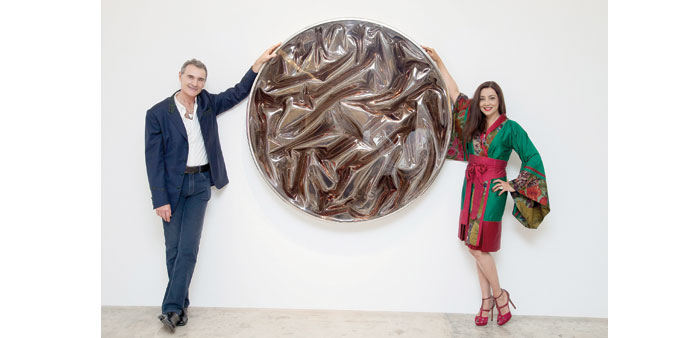NOT JUST EYE CANDY: Artist Mauro Perucchetti and his wife Lorena with one of his works, at the Anima Gallery, The Pearl.
By Anand Holla
If there is one art exhibition you can make time for in the coming weeks, make it Italian artist Mauro Perucchetti’s delightfully relevant Resinification at Anima Gallery, The Pearl, which has now been extended to January 11.
Few contemporary artists have been able to create works that mirror the modern social environment in which we live, as effectively and charmingly as Perucchetti does. And he does so by pulling in a range of shiny, sparkly mediums such as crystals, chrome, gold and steel, irresistibly pleasing to the eyes and the sense of touch, a reflection of today’s materialistic desires.
At the heart of his creations, which first captivate you with their marvelous hues and flawless finesse and then gradually compel you into examining the hollowness of consumerism, is ambivalence. Perucchetti’s colourful work draws from Conceptual, Minimalist, and Pop Art traditions, and over time, he has come to be known as a pioneer in the use of resin.
At Anima, several of Perucchetti’s vibrant works – mixed media and sculptures – get the space and stage they deserve. Large plain white walls are deliciously punctuated by poppy, minimalistic resin art that are as much about thought-stirring social commentary as they are about aesthetically adorable figures and frames.
Iliana Kodzhamanova of Anima Gallery told Community about the significance of the exhibition, “Anima Gallery is very pleased to showcase Italian artist Mauro Perucchetti. His exhibition is very special with diverse colourful works. It includes wall sculptures, standing sculptures as well as the famous Jelly Babies. Especially for our exhibition, Mauro made the Arab Jelly Babies; a strong statement reflecting the natural and essential dialogue between civilisations.”
For his astute ability to mould symbols into multi-pronged tools of meaning, Peruchhetti has often been regarded as an artist who “has his finger firmly on the pulse of contemporary society.” Take one of his signature creations – the Jelly Belly. The playful, candy-like pieces in little human forms, for Peruchhetti, symbolises “the disposability that permeates all aspects of the contemporary consumer society.”
On this point, Art critic Edward Lucie-Smith, in his essay, explains, “Peruchhetti uses it to mock the aspirations that this society claims that it has, but which it so often cynically betrays”.
In his statement, Perucchetti writes that he “unites Pop aesthetics with social comment to address some of the most pressing and difficult issues in today’s society in a way that is subtle and accessible, without being trite, shocking or obscure.” His influences, from time to time, show up in his cheery references to other artists such as Andy Warhol, Jeff Koons and Piero Manzoni.
For instance, his Modern Heroes series puts a clever contemporary spin on well-known sculptures. These “classic-pop, fibreglass re-imaginings of works” by legends such as Michaelangelo and Auguste Rodin, among others, features an interesting pairing of Superman and Batman in the style of pristine white marble sculptures.
Award-winning poet, writer and art critic Sue Hubbard, in her essay on Perucchetti, points out the irony at the heart of Perucchetti’s work for how it critiques the consumerist society, and yet is also part and parcel of it: “Essentially a Pop artist he seduces the viewer with his playful, jewel-like substances, the sweetie colours of his market-inspired objects. Beautifully made, his work is opulent and kitsch yet, like the iron fist in the velvet glove, it delivers a far greater punch than the apparent froufrou character at first suggests.”
Hubbard further remarks, “He is not keen on artists who shock as a form of protest. He would rather seduce his viewer with the visual glitter of his work, letting them imbibe his message in their own time.”
Anima Gallery refers to art critic Michael Bracewell’s piece on Perucchetti, to elaborate further. “Perucchetti creates objects which are political, cartoon like and steeped in the language of consumerism; but the basis of their effect – their aesthetic and conceptual trigger – is created through the artist’s unique use of resin as a medium for sculpture,” Bracewell writes.
“Indeed, this adaptation of a material at once liquid and solid, transparent and vibrant, is the physical summary of Perucchetti’s entire creative idiom: that which appears brightly and benignly coloured, simple, innocent and welcoming to the touch, is also eloquent of violence and destruction, charged with social comment, and descriptive of a contemporary world in which superficial appearance is used to mask and beautify ethical and spiritual dereliction,” Bracewell points out.



